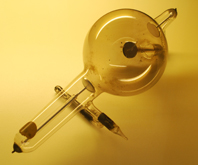X-rays were discovered, almost by accident, by a somewhat eccentric professor named Wilhelm Conrad Rontgen in 1895. Rontgen never graduated from high school but attended the University of Utrecht in 1865. Here he discovered that it was possible to enter the Zurich Polytechnical School, in Switzerland, without the qualifications he lacked. In November 1865 he consequently became a student of mechanical engineering, and eventually worked with the famous Dr August Kundt, a theoretical physicist. In 1874 Rontgen became an instructor at the University of Strasbourg, and later an assistant professor. Rontgen isolated himself from society to a large extent. His wife was chronically ill and he cared for in the best way that he could, but this responsibility also served to increase his social isolation. He was a keen photographer, and went on to work at the University of Wurzburg where he became head of the physics department. However, his teaching and communication skills were not highly regarded.
 |
| By me (my own camera) [GFDL (http://www.gnu.org/copyleft/fdl.html) or CC-BY-SA-3.0-2.5-2.0-1.0 (http://creativecommons.org/licenses/by-sa/3.0)], via Wikimedia Commons |
During November 1895, Rontgen, aged 50, was investigating the properties of a new version of the Crookes tube in his laboratory. He wanted to determine whether some of the radiation produced passed through the glass of the tube as he suspected they might. In a darkened laboratory he covered the tube with black cardboard and was surprised to see a greenish yellow glow appear on a screen some distance from the tube in a direction unshielded by his cardboard screen. He therefore moved the screen further away from the tube and repeated the experiment. When the screen glowed in a similar manner, he then positioned a two-inch thick book and a deck of cards between the tube and the screen. The result stopped him in his tracks because the rays clearly penetrated the materials. Finally, he placed wooden box containing metal weights in the path of the rays and found that a shadow of the metal objects was cast on the screen. The image shows Rontgen's original version of Crooks tube.
Rontgen now focused his attention entirely upon the new phenomenon. A few weeks later, while holding a lead pipe in the rays with his hand, the bones within his fingers were shadowed on the screen. Unable to believe his eyes, Rontgen shared his discovery with his wife and made the now famouus X-ray image of her hand.
Rontgen realized that the phenomenon could easily be discovered by other physicists, so kept his work secret while he wrote a paper entitled "On a New Kind of Rays" for the Physical Medical Society of Wurzburg. This was published in the December issue. Copies of his paper, together with photographs of his wife's hands, were also sent to several of Europe's most important physicists on New Year's Day 1896.